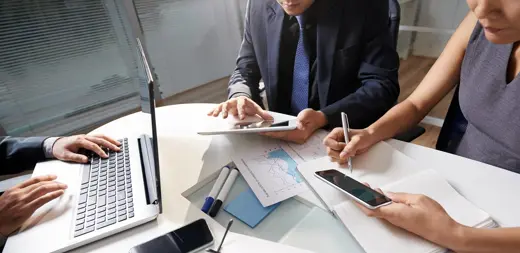By delving into these approaches and understanding their implications, asset managers can position themselves for success in an increasingly competitive landscape while driving efficiency, resilience, and value for their stakeholders.
1. Outsourcing internal functions
Context: Many private asset managers with traditional closed-end structures historically relied on internal technology and operations teams to perform core back-office functions, including investor onboarding, drawdown management, fund accounting, financial reporting, and SPV administration.
Challenge: These legacy setups have come under considerable pressure when faced with the operational and technological requirements of expanding into new asset classes, jurisdictions, and structures (e.g., hybrid, evergreen, ELTIFs). The middle and back-office capabilities required to support portfolios, funds, and structures in, for example, private credit or real estate debt are considerably different from pure equity strategies. Similarly, the technology, processes, and expertise needed to support open-end, or hybrid structures differ from traditional closed-end setups. These capability gaps present opportunity cost in staying agile or having to engage in extensive P&L planning when evaluating a new investor or strategy, considering the required investment in systems, personnel, and the timeline to build.
Solutions: Today, numerous service providers offer established third-party administration, supporting core "outsourcing models" for functions such as fund and SPV administration.
Considerations: Yet, as managers also look to cover different asset classes, structures, jurisdictions, and consolidate data across them – a key consideration in defining the future state is to consider partners who can enable access to a wide breadth of technology, expertise, and geographical footprint. Today, the ‘one-size-fits-all-model’ is insufficient. Multi-strategy, asset class, structural, and jurisdictional growth requires an integrated technology and operations support model across multiple platforms, supplemented with global coverage and delivery mechanisms.
2. Consolidation of multiple outsourced relationships
Context: Multi-strategy asset managers with $30bn+ in aggregate assets have, in many instances, organically and through M&A, found themselves with multiple outsourced partners offering little in terms of scaled economies.
Challenge: The natural outcome from this scenario is a significant divergence of processes and output across major client-facing areas, including investor onboarding, portfolio, and fund-level data, and investor reporting. In addition, these managers are encumbered with the management of these relationships and differing SLAs, outputs, and levels of service.
Solutions: Accordingly, an increasing number of institutional managers are looking to consolidate their relationships and invest in deeper partnerships that will drive financial savings, create operating scale, and improve efficiencies across processes, all with a view to ultimately benefit the end investor.
Considerations: Key considerations in selecting core partners are their substance, flexibility, and scale to support the migration of structures and portfolios. Moreover, ‘fit-for-purpose’ technology and operations aligned to specific strategies that integrate across broader platforms are critical features for any selected partner. Lastly, managers’ needs have extended materially beyond ‘just fund administration’ to support more across the capital initiation, allocation, deployment, and valuation lifecycle.
3. Co-sourcing models
Context: The traditional outsourcing model continues to evolve, and recently, we’ve seen a resurgence in co-sourcing or co-teaming engagements, which themselves can take a wide variety of shapes and forms. In many instances, managers may have deeply invested in proprietary technology or tailored third-party platforms. They may also have taken a view on owning and governing their data.
Challenge: In the context of inflation, the ‘great reshuffle’ while also managing expansion into new structures, strategies, and jurisdictions, firms are challenged with (a) being able to identify, secure, and manage growth hires to keep pace, and (b) increasing technology development, and licensing costs.
Solutions: Upon identifying the functions where leverage is needed, managers can work with firms that bring the required expertise to build and deliver dedicated operations teams that leverage global operating models and adjacent technology. These engagements provide several benefits, including resilience, and cost-avoidance, by shifting the burden of human resource management to a partner. Meanwhile, the manager retains direct access to their own technology and data whilst enhancing their operating abilities.
Considerations: Amongst other criteria discussed in the above scenarios, managers must focus on the specific processes, technology, and functional requirements they are targeting. Then, in the process of selecting a partner, they’ll need to consider the expertise, experience, and demonstrable global operating models available to ensure the pro forma engagement is constant and consistent between the two firms. In a nutshell, the desired target is a support structure where it is difficult to distinguish between the two firms who have partnered to achieve ‘operating leverage’.
4. Lift-outs
Context: In reconfiguring their business setup for agile growth, managers are looking to transition teams, entities, or functions to strategic partners. The scope of activities to be lifted out can include technology, legal entities, and importantly, people. While these initiatives have traditionally focused on core administration and middle-office operations, the scope of consideration has changed in recent years. Due to increasing costs, substance, and regulatory requirements managers are now also evaluating their local and regulatory footprint by seeking to lift-out their own Management Company (AIFM) teams in jurisdictions such as Ireland, Luxembourg, and the UK and moving to a pro forma outsourced ‘super ManCo’. The focus of these initiatives is to ensure continuity of model, investor servicing, and reduce the regulatory exposure of their own firm as facing multiple regulators from a fund management and distribution standpoint brings significant exposure and cost.
Challenge: Years of organic growth and investment in functional talent and technology have resulted in unintended cost allocations, increasing overheads, and management bandwidth on non-core activities. These issues are compounded by M&A activity. Yet, envisioning a previously internal capability to work at par or better as an external utility can be a challenge, despite the cost synergies presented in a pro forma financial model.
Solution: ‘Lift and shift’ initiatives are still the fastest and most efficient way for managers to achieve a seamless outsourcing arrangement while still benefitting from the retention of knowledge and talent built over years. Managers also achieve cost synergies by reducing entities, releasing of regulatory capital, decommissioning technology, and reducing support infrastructure whilst simultaneously future proofing with a robust operating model that frees managers to go back to focusing on investors and investments. Meanwhile, the selected partner embeds the transferred team and potential technology into their own support ecosystem. By virtue of a lift-out transition, or variations of outsourcing arrangements firms are also meeting their sustainability goals by building resiliency in their overall operating model against geopolitical and regulatory changes.
Considerations: Once the difficult task of identifying and distinguishing between core and non-core in-house activities is completed, managers must select a partner who can satisfy a wide set of required characteristics. In addition to having scale, presence, reach, technology, and flexibility, the service provider needs to prove their integration experience. Beyond the commercial benefits and ability to transition IT, data, and workflows, it is important for a selected partner to provide an ecosystem that will preserve and promote the key asset being transitioned – the people. Therefore, demonstrable experience in migrating, retaining. and leading people through a significant change is a key feature of any lift-out consideration.




